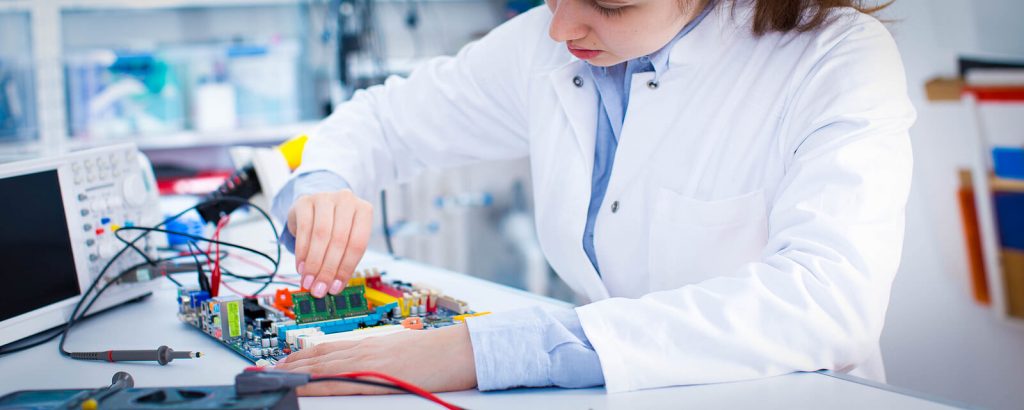The profit of a PCB manufacturer depends on various business metrics that indicate the critical performances of an assembly unit. One such parameter is the Line Efficiency which shows the ratio of the number of hours for which the components are placed on a PCB by a pick and place machine against the number of hours the staff attends to the SMT assembly line.
Line Efficiency = Total hours of parts placed on the PCB by a Pick & Place machine divided by Total hours of the staff attending the SMT assembly line.
These business metrics are easily measurable and assist in improving efficiency over a while. They help in tracking and analyzing the overall performance and guide the manufacturer in decision making.
There are two ways of measuring the Line efficiency in a PCB assembly unit. They are:
- Production Line Efficiency
- SMT Line Efficiency
Many PCB manufacturers rely on the SMT line efficiency to provide more precise and consistent results.
Production line efficiency is considered incomplete as it doesn’t include the actual labor consumption. The ratio is calculated on the actual staffed time than the optimum time. The assembly supervisors face the challenges of outside parameters that affect the line efficiency, and hence determining the production line efficiency becomes a difficult task.
SMT line efficiency is the widely accepted performance metric. It can be easily calculated based on the placement time and the staff time that is easily retrieved from the logged records. In this case, the staff time includes the breaks allowed to the employees. A well-planned shift routine enhances the SMT line efficiency. This reliable method provides a strong base to track the effects of any change introduced and its effect on line efficiency.
The data collected for calculating the line efficiency should be analyzed to identify any degrading factors. An effective evaluation can help in finding possible reasons for a lagging productivity line as:
- Functioning or maintenance issues of the equipment
- Inadequate Line setup causing logistics problems.
- Unproductive staff count than the required number.
- Ambiguous information on the set target can affect the staff’s performance.
Line efficiency is a crucial business metric used as a benchmark to evaluate the assembly resources output. It is complemented with other key indicators like Overall Equipment Effectiveness (OEE) and Overall Resource Effectiveness (ORE) while evaluating the production performance. Achieving the set line efficiency helps CMs reduce the staff count and increase the part placement count per line. This avoids any tailback delays on the assembly shop floors.
PCB manufacturers are opting for high-mix manufacturing wherein multiple sets of diverse products are produced simultaneously. Optimizing the yield in such situations depend on the changeover time also. Shifting from one product batch to another is limiting the overall utilization of the Line assembly.
To improve the line efficiency, a few more alternate methods are introduced as discussed below:
Overall equipment effectiveness (OEE) is a measure of the equipment performance and can detect six types of losses as follows:
- Breakdown losses caused due to unanticipated equipment failures.
- Setup or adjustment losses due to process failure while changing or adjusting the equipment position.
- Performance losses due to production interruptions by idling or small pauses caused, like parts obstructing a sensor.
- Losses due to the reduced speed of operation as against the equipment’s design specifications.
- Losses due to process defects reduce the quality requirements.
- Yield losses due to equipment ramp-up issues. Initial few outputs may not meet the quality specifications and have to be discarded.
The OEE metric can highlight the equipment performance issues and supports in improving the production process accordingly. But it cannot identify issues related to material usage, handling staff, or the working environment.
Overall resource effectiveness (ORE) is an upgraded method to include all the resources that were missed out on in the previous metrics. It addresses the losses associated with resources like material availability, workforce availability, facility readiness, changeover efficiency, etc. The total production time depends on various internal and external factors.
- Preparatory work or downtime affects the planned production time
- Facility availability or breakdown time can delay loading time
- Setup and adjustment losses can impact the operating time
- Material shortage or Workforce shortage may increase the run time
- Performance loss and Defect loss can degrade the effective time and the overall resource efficiency.
Choosing the right metric depends on the production line specifications. In high-mix productions, monitoring and improving the line efficiency is a continuous process. The equipment working at the optimal level and the maintenance cost decreasing considerably are sure indicators of growth in the PCB manufacturing industry.
Thus, Line efficiency is one of the key performance indicators in the PCB manufacturing industry. Higher the line efficiency, the quicker is the production turnaround time. Fully assembled and tested PCBs increase the production yield and also the profit. Conversely, a lower line efficiency indicates a failing business and highlights the reason for the performance degradation. Closely monitoring the Line efficiency metric is a must for any contract manufacturer.
The complexity of PCB design and manufacturing processes has increased the challenges for contract manufacturers. The growing demand for high-mix manufacturing has also hugely impacted the efficiency of the production lines. Contract manufacturers are expected to handle all these challenges efficiently.
Automation is one of the evolving solutions to regulate production lines in a PCB assembly unit. There are many software tools available in the market to maximize line efficiency as they serve as the standard to quantify manufacturing productivity. PCB manufacturers are using these metrics to reduce the production shutdown time and increase revenue every year. It’s very obvious that Line efficiency is considered an important business metric in the PCB manufacturing industry.


